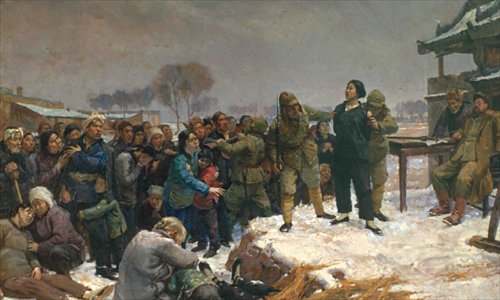 |
|
Liu Hulan's Heroic Death (1957) [Photo: Courtesy of the National Art Museum of China]
|
Walking around Art for Life, an exhibition at the National Art Museum of China (NAMOC) celebrating the 100th birthday of realist painter Feng Fasi (1914-2009), feels like traveling through time back to China's years of war and disorder during the 1930s-40s.
Opened on Friday, the exhibition boasts more than 200 art works painted by Feng during the 1930s through to the 1950s that realistically depict the different periods Chinese progressed through, particularly the War of Resistance against Japanese Aggression (1937-45).
Painting history
For elderly visitors to the exhibition, people who experienced China's dramatic changes first-hand, Feng's paintings can take them back to old days of hardship, struggle and war. As for younger visitors, the exhibition provides the perfect chance to learn more about history.
Feng was one of the few artists that traveled with the Eighth Route Army after the war against the Japanese invasion started in 1937. Joining the Anti-enemy Drama Cast established by Zhou Enlai, they performed plays for soldiers on the front-lines and used music, fine art, dance and other forms of art to encourage people to fight back against the Japanese invaders.
During the years he traveled with the army, Feng created numerous oil paintings and sketches that recorded the war and life of soldiers. Unfortunately, most of them were lost amid the rapid changes occurring at the time and only a small number have survived to today.
The exhibition at NAMOC focuses on two major periods in Feng's artistic career: The time during the 1940s he spent in the Eighth Route Army as a member of the Anti-enemy Drama Cast and the 1950s when he studied under famed Russian artist Konstantin Maksimov who had come to China from the Soviet Union.
During this first period, in spite of the difficulties posed by his situation, Feng managed to create a large number of works, including paintings and sketches, that show the living conditions of people during this period of time when the country was experiencing instability and harsh conditions.
A giant oil painting, Quarrying in Mountain (1944), depicts workers digging into a mountain to build a road for transporting supplies to the Chinese army. With forceful brushstrokes, it demonstrates the passion and perseverance of ordinary workers fighting against the Japanese invasion together with the army.
The Cast's Morning Meeting (1948) is Feng's most representative work of this period. It's probably the only painting in China that precisely depicts the life of the Anti-enemy Drama Cast during the war. Giving people a glimpse into the everyday life of the cast, members are seen sitting or standing under a leaking shelter discussing their work and full of vigor despite the rugged conditions.
His other works in this period such as Catching Lice and The Soldier Starved to Death reflect the misery Kuomintang soldiers experienced during the war while at the same time showing the painter's sympathy for soldiers.
A witness of history, Feng captured a realistic picture of life at the time from fine and artistic angles, meanwhile also showing his humanistic solicitude for workers and soldiers.
"Feng swiftly catches meaningful scenes in the front and the back area like soldiers in a rapid march, which is innovative and profound… They are precious treasures from the war," famous painter Xu Beihong once commented in an article.
We Recommend:
